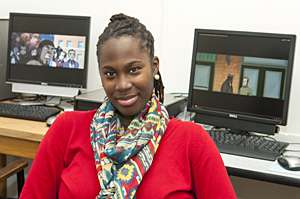Is everybody laughing when racially-charged comedy is viewed with multiple-race audiences?

New research finds that when viewing black-oriented entertainment television that evokes black stereotypes in its comedy, black audiences are more comfortable watching the programming among their black peers than among their white counterparts, and viewing conditions did not make any difference among whites.
The study led by Omotayo Banjo, a University of Cincinnati assistant professor of communication, is published online in Journalism & Mass Communication Quarterly and will be appear in the fall issue of the print publication.
The article states that "The study examined the interaction between content and context, with an emphasis on viewership of a television comedy that pokes fun at and occasionally disparages black in-group members."
Participants were invited to watch an episode of "The Boondocks," a black-oriented comedy program based on a syndicated comedy strip by Aaron McGruder. The show is featured on Cartoon Network's late-night Adult Swim time period.
"The show holds controversial content that has implications for racism or racist ideas," says Banjo. "So, how do audiences of different races perceive that? If we've moved past race as an issue in the U.S., can we watch this kind of content that is meant to challenge our thinking or make us laugh about our racism? And can different races do that together and feel comfortable?"
The study focused solely on recruiting participants who reported being black/African American or white/Caucasian. The participants were interviewed about their feelings after watching the show with two other black audience members, and watching the show with two white audience members. The two co-viewing audience members were paid actors prepared by the researchers to take part with the viewer as the program got underway.
The episode of "The Boondocks" used in the study was titled "Return of the King" and is considered one of the series' most controversial episodes, centered on the Rev. Martin Luther King Jr. awakening from a coma and discovering current black culture.
The study examined several different variables in regard to audience enjoyment from a scale of 1 to 7, with 1 being not at all similar and 7 being very similar. The variables included:
- Perceived similarity to the main characters, in terms of lifestyle, cultural background, appearance and basic values.
- Identification with characters – Viewers were asked if they wanted to be like the main characters, or if they felt that they related to an ethnic group from which the viewer was a member.
- Whether viewers felt excitement – Relaxed/stimulated; calm/excited; sluggish/frenzied; dull/jittery; sleepy/wide awake; not aroused/aroused.
- Whether viewers felt absorbed in the show – The show held their attention; they felt like they were part of the show; they were caught up in the show; they enjoyed watching the show.
The study found that black participants reported more positive excitement, attitudes and absorption than whites when viewing the program. However, blacks reported more identification and perceived similarity when viewing with all-black audiences than viewing with white audience members.
Ultimately, the study found that black viewers had a more rewarding experience viewing the show than their white counterparts, and that black viewers reported greater similarity and identification with characters in black-oriented media when they were viewing with black audience members than when viewing with white audience members.
The paper states that findings revealed no effect of co-viewing on the white audience reactions.
"African Americans, because of their position in society, are much more sensitive to difference, and so we weren't surprised that we saw these outcomes," says Banjo.
"It is possible that both black and white participants' responses were influenced by sanctions or other social expectations," write the authors.
The article also states that while an overwhelming amount of research on co-viewing influence has focused on family viewing habits, research on co-viewing programs with friends or with strangers is rare.
A total of 112 people took part in the study – 53 African Americans and 59 white participants. The average age of participants was 21. Sixty-eight percent of the participants were female and 32 percent were male.
Banjo's research focuses on representation and audience responses to racial and cultural media, as well as the impact of media messages on an individual's perception of self and of others.
More information: "Co-Viewing Effects of Ethnic-Oriented Programming: An Examination of In-Group Bias and Racial Comedy Exposure." Journalism & Mass Communication Quarterly 1077699015581804, first published on May 26, 2015. DOI: 10.1177/1077699015581804
Provided by University of Cincinnati


















